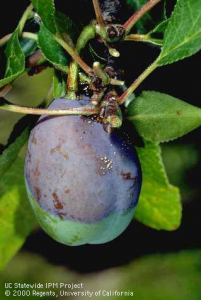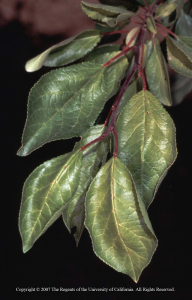The 2016 prune crop in California is forecast to be 45,000 dried tons, or about 1000 lbs dried fruit/acre based on current acreage data provided by growers. A light crop challenges growers and the industry as a whole. Growers lose income and the industry struggles to maintain market share in an already competitive world market. Growers must manage for a successful future using the limited income of today. The crop for next year is beginning to develop this year, so deficiencies this year can limit the crop next year. Cutting back instead of eliminating inputs/investment is the best approach in a year like this, keeping in mind that next year might be tough, too, if there is a big crop that has to be farmed with the light returns from this year. The following are some practices to consider in every year, modified in light of the challenges of a light crop.
Harvest prep. If you have a light crop, consult with your insurance company about whether to harvest. Some companies deduct the value of the fruit in the orchard from your payout.
Prunes should be ready about 30 days after first color. Look for color change on good, sound fruit (not “blue prunes”) and clean up your refractometer and pressure gauge once color shows in those fruit. As it looks now, harvest should begin about the same time as last year – early to mid-August for shaker startup – with most of the acres finished by the end of August. In a light crop year with costs high, why pick early and leave fruit on the tree? Schedule harvest by tracking fruit maturity with fruit pressure gauge. Fruit pressure, not sugar or fruit color, is the most accurate measure of maturity. Fruit is ready to harvest when pressure drops to between 3-4 lbs. In a light crop year when dryer space shouldn’t be too tight, waiting until closer to 3 lbs to start harvest might help reduce costs. Harvesting fruit at proper maturity helps maintain California’s reputation as the world leader in high quality prune production.
Run a field sizer on a short crop? In a normal year, running a small sizer (for example, 15/16-inch) to remove garbage and damaged fruit can help keep the delivered fruit clean. In a short crop year, check with your packer to see about their payment plan and if leaving off the sizer and delivering all fruit makes economic sense.
Preharvest irrigation water shut off. Properly timed irrigation cut off will help reduce 1) bark damage from shakers, 2) fruit dry-away ratio, and 3) premature fruit drop.
Use fruit pressure information to predict start of harvest (fruit pressure drops 1-2 pounds/week; ideal harvest pressure = 3-3.5 pounds fruit pressure this year) and then use predicted harvest date to decide irrigation water preharvest timing. Grower experience should determine when irrigation water is cut off in a specific orchard. Orchard health, soil type, and cropload all influence the cutoff date for irrigation. A 3 year study by UC showed that healthy, mature prunes were not harmed – tree health or crop yield – when irrigation shut off was 5 weeks before harvest. In the same study, water shut off 22 or 30 days ahead of harvest significantly reduced dry away, from 3.1 to 2.9 compared to water shut off at 12 days before harvest. (See research report for full details). Wet (irrigated) orchards show the most premature fruit drop when night-time temperatures drop to around 50oF.

Premature fruit coloring and gumming from a brown rot infection. Photo: UC Statewide IPM Project.
Preharvest brown rot sprays can reduce fruit brown rot in orchards where brown rot has been or might be a problem. However, brown rot is more of an issue in clustered fruit and there isn’t much clustered fruit in many of the orchards I’ve seen. Talk with your PCA about the pros and cons of a preharvest fruit brown rot spray. Weigh the added cost of a fruit brown rot spray against the risk of fruit damage in a light crop year. See the UC compilation on fungicide efficacy and timing for material options. In a light crop year, the cost of a brown rot spray might be better used on something else, such as preharvest clean up or nutrient sampling.
Watch pests and tree water status. Monitor blocks for spider mites, rust, and water status approaching harvest. If spider mite pressure is building right before harvest, consider a potassium nitrate spray to “top off” the potassium levels in the trees and suppress adult spider mites for 2-3 weeks. Leaf loss from mites, rust, and/or water stress slows harvest as blowers work to keep extra leaves out of the bins and also exposes scaffold branches to sunburn in the postharvest heat of August and early September.
Clean up orchard before harvest. Cut out dead and dying limbs, suckers, etc. prior to harvest. This will reduce harvester and/or tree damage and make for a faster, cleaner harvest. If woody suckers at the trunk base are not removed ahead of harvest, the suckers can damage the tree bark when the shaker clamp grabs the tree. Cutting out damaged branches will protect employees and shaker tarps from flying wood at harvest and also help renew the orchard.
Cutting out dead and diseased wood is really important for older blocks with a lot of dieback due to Cytospora canker. There is no fungicide to get rid of Cystospora. Dead and/or diseased wood must be cut out and removed from the orchard to improve orchard health. The cankered wood is much easier to see before rather than after harvest. See the pocket guide for “good” vs. “bad” saw cuts to help avoid the problem of not cutting far enough down the branch to remove all the canker (laminated shirt-pocket cards are available at the UCCE Yuba City office).
If cutting and hauling dead branches is too much to consider before harvest, think about sending a trusted employee (or the owner) through a block and mark cutting points with paint. When the pruning crew comes through in the fall, they can make the right cut quickly.

Potassium deficiency symptoms in prune. Photo: UC ANR.
Take leaf samples in July. Even if your bank account/cash flow is suffering, you still need to know what the “nutrient account” looks like in the orchard. The cost of leaf analysis is a few dollars an acre and the results can help you go into the new year with adequate nutrition. Key nutrients to check are nitrogen (N), potassium (K), and zinc (Zn). Add chloride to the analysis request if you use muriate of potash (MOP, potassium chloride) as a potassium fertilizer. If you have switched from surface to ground water irrigation source, definitely consider chloride, sodium and boron in the lab analysis request.
Make sure the sampler is trained on what leaves to sample. Expensive decisions are made based on leaf analysis results, even if the practice itself is not costly. Sampled leaves (1-2/tree) should come from healthy, non-bearing spurs from representative trees across the block for a total of 50-75 leaves/sample. Avoid weak trees. Call your farm advisor for UCCE recommendations for interpreting prune leaf analysis results.
Given the expected cutbacks in a fertilizer program in a light crop year, July leaf sample analysis results are especially important to allow time to make fall applications of N, K, or Zn to be ready for new crop in 2017.


Leave a Reply